«previous pageANALYSIS & PLANNING CATEGORY
Honor Award
Greensburg Sustainable Comprehensive Plan, Greensburg, KS
BNIM, Kansas City, MO
client: City of Greensburg
Project Statement
It is human nature to revert to survival mode after a devastating event like the tornado that struck Greensburg, destroying over 90 percent of the town's buildings and structures. Despite the physical and psychological strain of the disaster, the people of Greensburg knew that in order to preserve the future of the town, they needed to step back and create a long term vision for rebuilding. That vision came in the form of a Comprehensive Master Planning Process.
Project Narrative
In the wake of an EF-5 tornado that hit Greensburg on May 4th, 2007, it became apparent that big changes would have to occur to sustain the town for future generations. Greensburg citizens believe they now have the chance to build a stronger, thriving community. With hope of overcoming population decline and a struggling economy, the citizens of Greensburg look towards a sustainable future that will truly make Greensburg a green community.
The immense challenges facing Greensburg’s reconstruction and the desire to embrace common sense green solutions make it an ideal candidate to become a model for the sustainable rural community. Greensburg, a town of 1,574 in Southwestern Kansas, has the opportunity to repair the destruction with a triple bottom line planning approach based on local values and a promising new way of life. Greensburg is a community with strong leaders who reach out to neighbors, a community where new businesses growth is built around sustainability at both a local and regional level.
The design intent of the Greensburg Comprehensive Master Plan underway will help the community become a socially, economically, and environmentally sustainable city. It is a document that emerged directly from the community and is representative of both the planning team’s recommendations, the City’s operational requirements and input from many stakeholder groups. This is not about disaster recovery but instead a strategy to benefit from an opportunity to build sustainable systems with flexibility for future generations from the ground up.
Process
From the start, Greensburg City staff was an integrated part of the planning team. They guided the work of the planners, informed the community and educated City officials about the plan and important next steps. City staff provided ongoing leadership in a time when strong direction was needed and acted as a constant advisor for the planning work.
The planning team learned a great deal about Greensburg from discussions with community members. Many of the concerns and issues will be covered in depth throughout the master plan, but a couple of recurring concerns are worth noting at this time because they set the tone for redevelopment.
The community sees the great opportunity that was presented by the disaster. They want to rebuild a progressive, inclusive town that provides jobs, education, and recreation to attract and retain a young generation of Greensburg residents. Like generations of Greensburg citizens before, they want to leave a legacy for their grandchildren and serve as an example for the Midwestern towns of tomorrow.
The Project Phases
Due to the immediate needs of the community, the process for completing the Comprehensive Master Plan was compressed into two phases lasting 6 months. Phase 1 presents the bones of the plan. This allows many important projects to keep their momentum while simultaneously planning for the future. Phase 2 is intended to deal with ongoing energy discussions, an economic development plan and the implementation plan.
Phase 1
In phase 1, the planning team addressed the most pressing needs of the City. These included the creation of Greensburg design goals and principles for rebuilding, a conceptual design scheme for downtown, a future land use map, zoning refinements, infrastructure analysis, preliminary housing policy recommendations, conceptual streetscape design for signature streets, preliminary energy-efficiency and energy policy recommendations, a strategy for building a highly walkable community, and a conceptual parks and open-space layout. Based on the vision for a “green Greensburg,” the entire Comprehensive Master Plan was built around the principles of economic, social, and environmental sustainability.
Phase 2
At the completion of Phase 1, the City will need to address other long-term needs for Greensburg. The topics to be covered in Phase 2 are as important as those in Phase 1, but slightly less urgent. Possible Phase 2 tasks include the completion of: detailed parks and open space plan, a cultural resources analysis, an economic development strategy, and an implementation program. Although Phase 1 is adopted as the legal plan for the City, some small adjustments could be made through further investigation in Phase 2.
Community Goals
In order to memorialize all the good community input to date, some goals were added, combined or cut to accurately reflect the rapidly developing consensus. The following goals serve as a living document providing guiding principles for the creation of the Greensburg Comprehensive Master Plan. Each of the following 11 goals was strongly considered as part of every recommendation in the plan. Accomplishing the community vision will require careful consideration of the connectedness and intent behind each goal.
- Community — A progressive community that offers urban services within the unassuming feel of a rural, Midwestern community.
- Family — A community that provides opportunities for its young people in the way of jobs, education and recreation as reasons to stay in Greensburg.
- Prosperity — A community where entrepreneurial spirit, customer service, and a sustainable economy permeate the business sector and where residents, travelers, and tourists enjoy a full line of locally-owned businesses that provide jobs and services to an exceptional example of small-town America.
- Environment — A community that recognizes the importance of the natural environment and balances the need for growth and economic development with the maintenance and improvement of the environment.
- Affordability — An up-to-date, affordable rural community where housing plans and strategies incorporate energy-efficient design and materials and serve as a regional and national model for integrating residents of all ages and needs with services of all kinds.
- Catalysts — The rebuilding process starts with the most stimulating structures and spaces. These will spawn further growth.
- Growth — A community that opens its doors to new residents and visitors without affecting the values and lifestyles of its current residents.
- Renewal — A community that makes proactive decisions that use this opportunity to reverse the decline of the community and build a progressive city with a strong future.
- Water — Treat each drop of water as a precious resource.
- Health — Improve quality of life by promoting a healthy and active lifestyle.
- Energy — Promote a high level of efficiency in new construction and look to renewable options for generation.
- Wind — Greensburg’s vast wind resources are part of an emerging economy and should be harvested.
- Built Environment — Build a town that encourages interaction between residents, welcomes guests and serves as a model community. New development should be durable, healthy, and efficient. City projects will lead the way by becoming examples of green practices that are built to last.
Project Resources
Residents of Greensburg, Kansas
Mayor
John Janssen
City Administrator
Steve Hewitt
Recovery Coordinator/Asst. City Administrator
Kim Alderfer
Planning and Zoning Administrator
Michael Gurnee, AICP
Treasurer
Pam Reves
Street Department
Mike Hayes
Utilities Director
Mick Kendall
Office Administrator
Stacy Barnes
Christy Pyatt
Planning Commission
BNIM — Sustainable Community Planning
Bob Berkebile
Stephen Hardy
Rachel Stroer
Aaron Ross
Jim Schuessler
Mark O'Hara
Greg Pfau
Celine Andersen
Tim Duggan
National Renewable Energy Laboratories
Lynn Billman
Duncan Prahl
John Thorton
Tom Wind
Gerry Harrow
Greensburg GreenTown
Daniel Wallach, Director
State of Kansas
Steve Weatherford, Governor’s Liaison
Kansas Energy Office
Russ Rudy
Kansas Communities
Terry Woodbury
USDA Rural Development
Chuck Banks
Tim Rodgers
Gary Smith
Brandon Prough
Professional Engineering Consultants, Inc.
Tim Lenz
U.S. Environmental Protection Agency
David Doyle
Chilton “Chet” McLaughlin
Federal Emergency Management Agency
Steve Castanar
Benjamin Alexander
Erin Miles
John Boyle
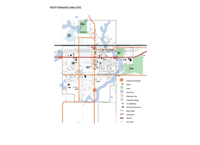
Post-Tornado Analysis
(Photo: © 2008 BNIM)

Land Use & Zoning
(Photo: © 2008 BNIM)
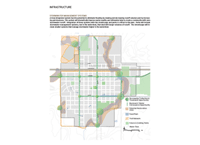
Stormwater Management Systems — A truly integrated system has the potential to eliminate flooding by slowing and decreasing runoff volumes and by increasing perviousness. This system will dramatically improve water quality and ultimately help to create a community with zero stormwater runoff. Integration of these systems with the streetscape and parks is critical to the plan. Parks will include stormwater management systems, low in the watershed, that deal with larger volumes of runoff. The streetscape will include smaller systems that manage stormwater higher in the watershed. (Photo: © 2008 BNIM)
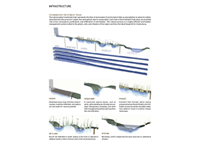
Stormwater Treatment Train — The natural water treatment train represents the flow of stormwater from the time it falls as precipitation to when it is either absorbed into the ground or rejoins the atmosphere due to evaporation. Each link in the treatment train plays an essential role in the conveyance, purification, and infiltration of stormwater. This natural process is a highly efficient stormwater management system suited to the plants, soils, and climates of the region and thus the ideal blueprint for Greensburg.
(Photo: © 2008 BNIM)
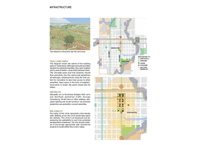
Trail networks in the prairie near the new school.
(Photo: © 2008 BNIM)
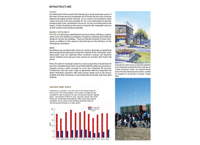
Greensburg’s wind resources have the potential to be harnessed by large wind farms, but also by smaller turbines in town. Turbines will power the new Greensburg Arts Center, created by students by University of Kansas’ Studio 804.
(Photo: © 2008 BNIM)
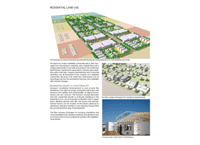
The Greensburg Transect illustrates development density at a scale designed for a small walkable community.
(Photo: © 2008 BNIM)

Downtown Land Use
(Photo: © 2008 BNIM)
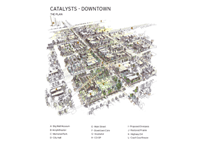
Catalysts — Downtown — The Plan (Photo: © 2008 BNIM)
"This story has captured the imaginations of the public and the practice. They've created standards that are pragmatic, modest, and achievable. A plan to which other towns should aspire."
— 2009 Professional Awards Jury
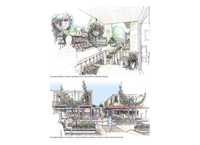
Renderings of the Sustainable Comprehensive Plan (Photo: © 2008 BNIM)

Catalysts — Downtown Streetscape(Photo: © 2008 BNIM)
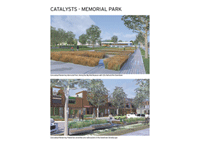
Catalysts — Memorial Park
(Photo: © 2008 BNIM)

Catalysts — City Hall
(Photo: © 2008 BNIM)
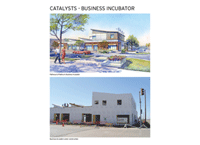
Catalysts — Business Incubator (Photo: © 2008 BNIM)

Catalysts — Big Well Museum (Photo: © 2008 BNIM)
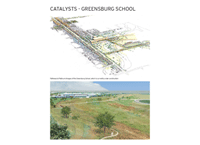
Catalysts — Greensburg School (Photo: © 2008 BNIM)

Sustainable Playground
(Photo: © 2008 BNIM)
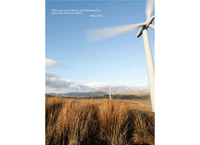
(Photo: © 2008 BNIM)



